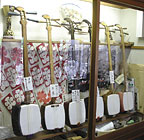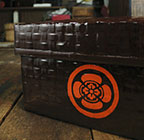|
|
|
|
|
||||||||||
HOME > the spirit of the brabd nihonbashi-bijin > Sou:Downtown of Artisans Passing Down Traditional Skills
Nihonbashi-bijin, Japan Beauty from Edo-Tokyo, who is beautiful in body and mind, is a woman who improves herself by placing importance on her characteristics. In Nihonbashi where unique culture has been developed for a long period of time since the beginning of the shogunate government of Edo, there are many tips for creating and developing individual characteristics.
Downtown of Artisans Passing Down Traditional Skills


Skills of Teue process, to put in natural hair into each hole of the brush.
Rihei, a founder of Edo-ya, started to craft hake makeup brushes for ladies within the inner palace of the Edo shogunate and painting brushes for the personal painters of the shogun. The shogun’s family gave him a shop named Edo-ya in 1718, so he opened Edo-ya in Odenmacho. Today, Edo-ya handles over 3,000 kinds of painting brushes for sliding screens and lacquer ware to brushes for the home and ones for semiconductor production. Teue is the most important process for ensuring quality. Wisps of natural hair are folded and then put into more than 100 holes by adjusting the amount and length to be the same. This can only be done by experienced craftsmen using their fingertips and hands very carefully. As people who once used it said, no one can use another brush, the quality and tradition of the products are supported by the faith and technique of the craftsmen.


Our spirits are put into leathering, or Kawabari
Bachiei, a shamisen house attracting many fans from geisha in Yoshicho to the people in Ningyo-cho where many plays were preented, is located in Amazake-Yokocho. The do, or the body of shamisen, and the sao, or neck, are separately made by different craftspeople, and Bachiei focuses on the assembly called shikomi. Among the processes of the shikomi, kawabari, or leathering the do, is the most difficult and requires the highest skill. Since it is easily affected by weather and climate, it takes the long experience of a craftsperson and intuition from all the honed senses in order to do this well and produce a charming sound. Bachiei also offers extended services including advice to beginners and maintaining shamisens in the best condition by checking the leather or tuning to maintain its quality. Shamisen is an indispensable item for further understanding the traditional entertainment of the Edo period and Kabuki.


Refined hanging scrolls
Kyoshindo Inazaki, founded between 1830 and 1843, is the leading framing business house (Hyougushi) called Daikyoji. Their traditional craftwork consists of mounting scrolls, folding screens, picture frames, and papered sliding doors. Making a hanging scroll, for example, requires a comprehensive understanding of artistic pieces, such as paintings and calligraphy, and the skill for selecting the forms of the scroll and materials for the clothes called kire, to add charm to it. Many processes using water, paste, and brushes are used to join Japanese paper and cloth, which shrink differently because of temperature and/or humidity. Those processes take a month or longer, or in some cases take over one year. Kyoshindo Inazaki now offers new style scrolls, folding screens, and picture frames with patterns and colors suited to modern houses.


Valued again by young people
Tsuzura had been used in Japan regularly to put kimono and accessories away in every house since the Edo period, as part of the trousseaus. Since there were many kimono stores in Nihonbashi, tsuzura stores were also everywhere. However, as lifestyles change with the decline in kimono culture in Japan, the number of tsuzura stores has gradually decreased as well, and there are only two stores left in Tokyo.
In the Iwai-Tsuzura-Ten, Japanese paper called washi is put over the bamboo basket, over which a mixture of persimmon and tannin for base coating is painted and then lacquered for finishing. Tsuzura products are traditional craftwork that are light and durable, let air through, keep kept moths away, and are beautiful to look at. Recently they have been valued again as articles of folk handicraft, becoming popular as interior items or gifts for foreign people.


Stylishness of Edo
Hamacho Takatora not only manages the processes for dyeing but creates original patterns, designs, and dyes in its products. The products, such as hanten (kimono style festival gowns), tenugui (Japanese washcloths), gassai-bukuro (Japanese pouches to put anything) and kakemori (Japanese pouches to put a charm) reflects the inherited techniques of craftspeople and spirits and stylishness of Edo. For some products, cool Edo style and wit that may be also understandable to modern people are reflected in the play on words. For example, a picture “Big Sheep means Beauty” as it is literally read from Chinese characters. Another one is the combination of tama ムballs and geta ムJapanese wooden clogs, which is tamageta, meaning “surprise.”
|



